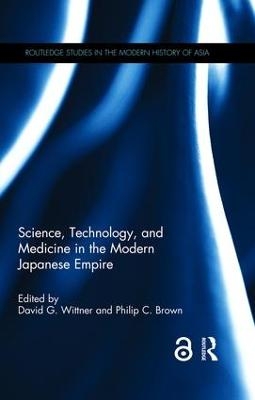
Science, Technology, and Medicine in the Modern Japanese Empire
Routledge (Verlag)
978-1-138-90533-7 (ISBN)
This book explores the ways in which scientists, engineers and physicians worked directly and indirectly to support the creation of a new Japanese empire, focussing on the eve of World War I and linking their efforts to later post-war developments. By claiming status as a modern, internationally-engaged country, the Japanese government was faced with having to control pathogens that might otherwise not have threatened the nation. Through the use of traditional and innovative techniques, this volume shows how the government was able to fulfil the state’s responsibility to protect society to varying degrees.
Chapter 14 of this book is freely available as a downloadable Open Access PDF at http://www.taylorfrancis.com under a Creative Commons Attribution-Non Commercial-No Derivatives (CC-BY-NC-ND) 4.0 license.
David G. Wittner is a professor of East Asian history and Director of the Center for Historical Research at Utica College, USA. Philip C. Brown is a professor at the Ohio State University, USA, specializing in early modern and modern Japanese history.
Introduction Part I: Science, Technology and Industry in the Creation of a New Japan 1 "Coke, Christ, and the Japanese Empire" 2 Academia-Industry Relations: Interpreting the Role of Nagai Nagayoshi in the Development of New Businesses in the Meiji Period and Beyond 3 An Emperor’s Chemist at War and in Peacetime: Sakurai Jōji during the Russo-Japanese and First World Wars Part II: State, Experts and Imperial Medical Policy 4 Cholera, Buddhism, and Public Health: The Story of an Ephemeral Chimera in Meiji Japan 5 Freedom of the Press during the Siberian Intervention: The Taisho Democracy and the Influenza Pandemic of 1918 6 The Politics of Manic Depression in the Japanese Empire 7 A Colony or A Sanitarium? : A Comparative History of Segregation Politics of Hansen’s disease in Modern Japan 8 "The Are Not Humans": Responses to Hōjō Tamio and Patient Writing Part III: Medicine, Race, and Empire 9 Dr. Baelz’s Mongolian Spot: The Contribution of German Medicine to the Racial Discourse in Meiji Japan 10 When Precision Obscures: Disease Categories Related to Cholera during the Sino-Japanese War (1894-1895) 11 Kampō in Wartime Sino-Japanese Relations: The Association of East Asian Medicine and the Search for a Tripartite Medical Partnership Part IV: Scientific Weapons and the Transformation of Pacific War Aims 12 The Question of Research in Pre-WWII Japanese Physics 13 Architects of ABC Weapons for the Japanese Empire: microbiologists and theoretical physicists 14 The Science of Population and Birth Control in Postwar Japan Afterword "Is There Anything Unique About Modern Japanese Science?"
| Erscheint lt. Verlag | 4.4.2016 |
|---|---|
| Reihe/Serie | Routledge Studies in the Modern History of Asia |
| Zusatzinfo | 22 Halftones, black and white; 22 Illustrations, black and white |
| Verlagsort | London |
| Sprache | englisch |
| Maße | 156 x 234 mm |
| Gewicht | 566 g |
| Themenwelt | Geisteswissenschaften ► Geschichte ► Regional- / Ländergeschichte |
| Geschichte ► Teilgebiete der Geschichte ► Technikgeschichte | |
| Studium ► Querschnittsbereiche ► Geschichte / Ethik der Medizin | |
| Naturwissenschaften | |
| Sozialwissenschaften ► Soziologie ► Spezielle Soziologien | |
| ISBN-10 | 1-138-90533-X / 113890533X |
| ISBN-13 | 978-1-138-90533-7 / 9781138905337 |
| Zustand | Neuware |
| Haben Sie eine Frage zum Produkt? |
aus dem Bereich


